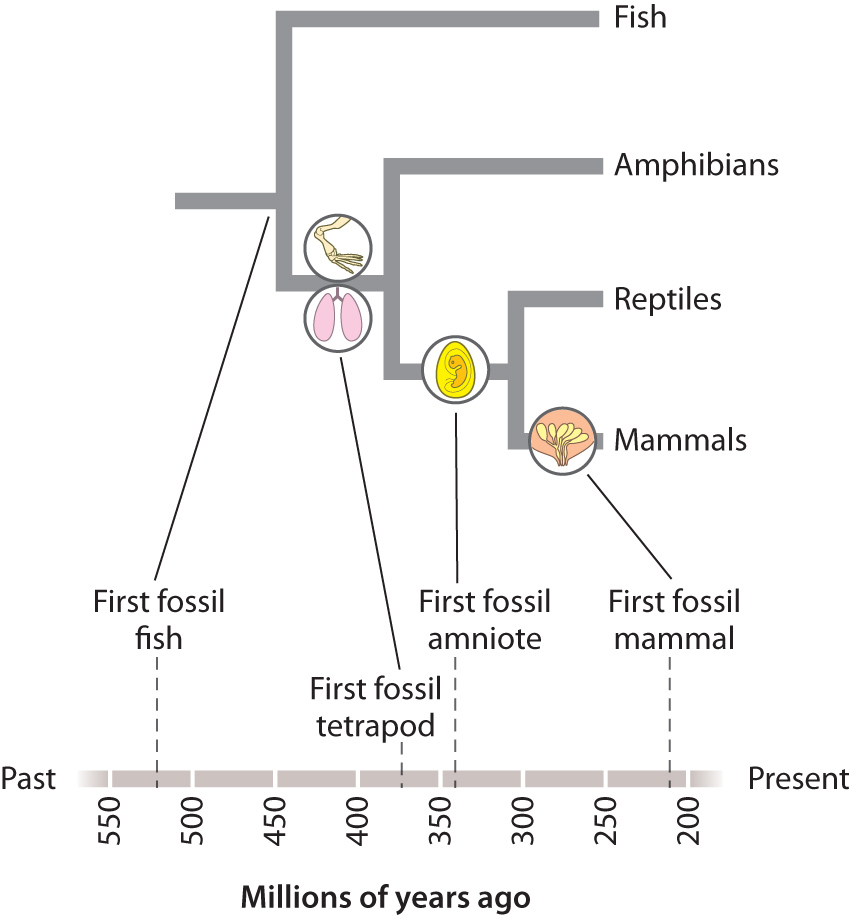23.4 COMPARING EVOLUTION’S TWO GREAT PATTERNS
The diversity of life we see today is the result of evolutionary processes playing out over geologic time. Evolutionary process can be studied by experiment, both in the field and in the laboratory, but evolutionary history is another matter. There is no experiment we can do to determine why the dinosaurs became extinct—we cannot rerun the events of 65 million years ago, this time without the meteorite impact. The history of life must be reconstructed from evolution’s two great patterns: the nested similarity observed in the forms and macromolecular sequences of living organisms, and the direct historical archive of the fossil record.
23.4.1 Phylogeny and fossils complement each other.
The great advantage of reconstructing evolutionary history from living organisms is that we can use a full range of features—skeletal morphology, cell structure, DNA sequence—to generate phylogenetic hypotheses. The disadvantage of using comparative biology is that we lack evidence of extinct species, the time dimension, and the environmental context. This, of course, is where the fossil record comes into play. Fossil evidence has strengths and limitations that complement the evolutionary information in the living organisms.
We can use phylogenetic methods based on DNA sequences to infer that birds and crocodiles are closely related, but only fossils can show that the evolutionary link between birds and crocodiles runs through dinosaurs. And only the geologic record can show that mass extinction removed the dinosaurs, paving the way for the emergence of modern mammals. Paleontologists and biologists work together to understand evolutionary history. Biology provides a functional and phylogenetic framework for the interpretation of fossils, and fossils provide a record of life’s history in the context of continual planetary change.
23.4.2 Agreement between phylogenies and the fossil record provides strong evidence of evolution.
Phylogenies based on morphological or molecular comparisons of living organisms make hypotheses about the timing of evolutionary changes through Earth history. We humans are a case in point. As discussed in more detail in Chapter 24, comparisons of DNA sequences suggest that chimpanzees are our closest living relatives. This is hardly surprising, as simple observation shows that chimpanzees and humans share many features. However, among other differences, chimpanzees have smaller stature, long arms that facilitate knuckle-walking (the arms help support the body as the chimpanzee moves forward), a more prominent snout, and larger teeth. Fossils painstakingly unearthed over the past century show that the morphological features that mark us as human accumulated through a series of speciation events. Six to seven million years ago, when the human and chimpanzee lineages first split, the two newly diverged taxa looked much more alike than humans and chimpanzees do today.

The agreement of comparative biology and the fossil record can be seen at all scales of observation. Humans form one tip of a larger branch that contains all members of the primate family. Primates, in turn, are nested within a larger branch occupied by mammals, and mammals nest within a still larger branch containing all vertebrate animals, which include fish. This arrangement predicts that the earliest fossil fish should be older than the earliest fossil mammals, the earliest fossil mammals should be older than the earliest primates, and the earliest primates older than the earliest humans. This is precisely what the fossil record shows (Fig. 23.22).
The agreement between fossils and phylogenies drawn from living organisms can be seen again and again when we examine different branches of the tree of life or, for that matter, the tree as a whole. All phylogenies indicate that microorganisms diverged early in evolutionary history, and mammals, flowering plants, and other large complex organisms diverged more recently. The tree’s shape implies that diversity has accumulated through time, beginning with simple organisms and later adding complex macroscopic forms.
The geologic record shows the same pattern. For nearly 3 billion years of Earth history, microorganisms dominate the fossil record, with the earliest animals appearing about 600 million years ago, the earliest vertebrate animals 520 million years ago, the earliest tetrapod vertebrates about 360 million years ago, the first mammals 210 million years ago, the first primates perhaps 55 million years ago, the oldest fossils of our own species a mere 200,000 years ago. Similarly, if we focus on photosynthetic organisms, we find a record of photosynthetic bacteria beginning at least 3500 million years ago, algae 1200 million years ago, simple land plants 470 million years ago, seed plants 370 million years ago, flowering plants about 140 million years ago, and the earliest grasses 70 million years ago.
In Part 2, we explore the evolutionary history of life in some detail. Here, it is sufficient to draw the key general conclusion: The fact that comparative biology and fossils, two complementary but independent approaches to reconstructing the evolutionary past, yield the same history is powerful evidence of evolution.